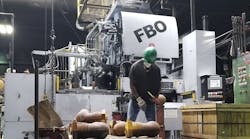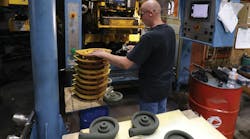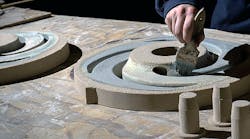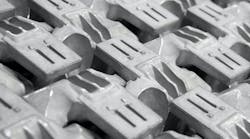Press building specialist Siempelkamp Maschinen- und Anlagenbau GmbH recently broken its own record for the heaviest ductile iron casting ever produced. The 312-ton component is the upper crossbeam for a closed-die forging press that Siempelkamp is rehabbing for Alcoa’s Cleveland Works.
The previous record for heaviest ductile iron casting was a 298-ton component that Siempelkamp cast in 2009. The company designs and builds forming presses for various processes (pipe, rails, and hydro-forming, as well as open- and closed-die forging.)
Alcoa chose Siempelkamp to rehabilitate its 50,000-ton press in 2009, and the 14 new components have been cast, finish machined, and shipped to the site for the rebuild. Ten of those castings weigh between 220 and 275 tons.
Siempelkamp details that the largest part — 36 X 13 X 9 ft. (10,900 X 3,950 X 2,740 mm) — was cast at its foundry in Krefeld, Germany, on July 8. The molten iron was poured at about 1,350 °C from five ladles in 120 seconds.
After cooling in the mold for about four weeks, the casting was lifted out of the casting pit and machined on high-capacity machines capable of handling parts with a clamping length of up to 22 meters. Siempelkamp claims it is the only press manufacturer capable of producing ductile iron castings and machining them on-site.
Alcoa’s project is part of a $110-million investment program it has said will make its Cleveland Works “the world’s premier producer of large aluminum and titanium forgings for the defense, aerospace, and industrial markets.” The company is preparing to fulfill its 10-year, $360-million contract with Lockheed Martin for the F-35 Joint Strike Fighter.
The upgrade involves replacing the heavy castings on the 55-year-old press. Siempelkamp analyzed the Mesta Machine design, conducted FEA calculations and optimized the machine according to the latest technology to achieve maximum component weight. It says the results will be structural components capable of withstanding decades of high stress.
Latest from Molds/Cores
Latest from Molds/Cores
Melt/Pour
Automated Pouring Takes on the Challenge
March 1, 2024
Issues and Ideas
Progress in e-Mobility Manufacturing
Feb. 29, 2024
Molds/Cores
New Molding Machine Fits Right In
Feb. 27, 2024
Molds/Cores
The Next Step in Horizontal Molding
Feb. 2, 2024
Molds/Cores
Change Is Now Non-Negotiable
Feb. 2, 2024
Molds/Cores
Foundry Starts 3D Printing Expansion
Jan. 4, 2024
Issues and Ideas
Cascade Die Casting Expanding
Nov. 28, 2023








